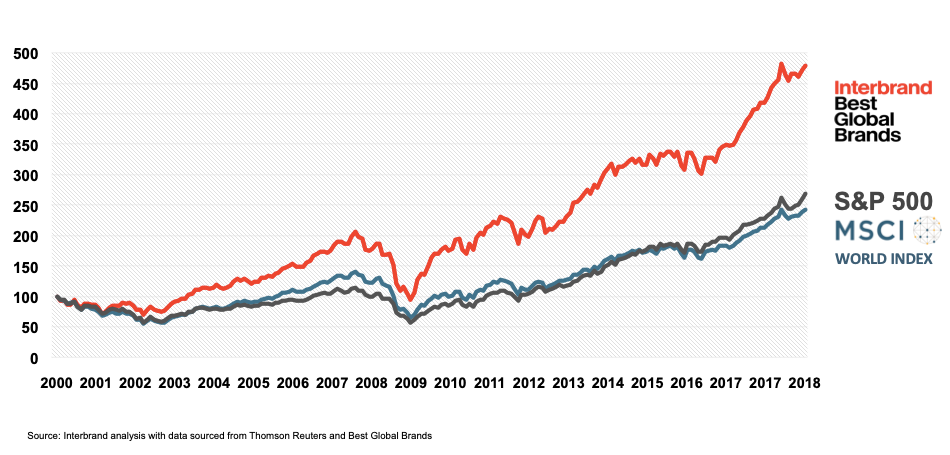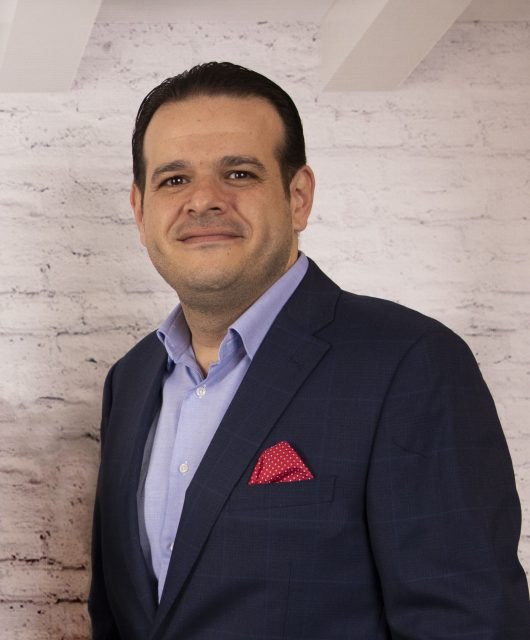Common Success Factors Of The Fastest Growing Brands
Businesses today seeking to build strong brands face numerous challenges. Hyper-competitive markets and improved product quality has led to an increasingly commoditised nature to many industries. Loyalty is harder than ever to establish, with consumers facing an abundance of choice and lower barriers to switching via digital channels. Consumer expectations are also rising so fast that many businesses are struggling to keep up, much less leap ahead.
Despite the turbulent times in which we live, it remains the case that strong brands continue to create sustainable competitive advantage for businesses. Interbrand data from its globally renowned Best Global Brands (BGB) ranking, published every year since 2000, shows the ‘BGB Index’ (an index of the total stock market returns of the companies owning the brands in our study) significantly outperforming a range of benchmark indices like the S&P 500 and MSCI World, with the outperformance accelerating in the years following the global financial crisis. To put it plainly, strong brands help to drive superior business results.

Interbrand analysis of Best Global Brands data over the last 5 years (2014-2018) has shown that the businesses with the fastest growing brand values significantly outperform their peers on Relevance and Responsiveness (two of the ten factors we use within our Brand Strength framework to diagnose opportunities and threats for a brand).
Given this landscape, and the growing challenges of building strong brands in the 21st century, we decided to take a deeper look at the fastest growing brands to identify how they remain relevant and responsive, along with other common success factors.
Success factor 1: Activating Brave
Our analysis showed that brands, like Adobe, Amazon, Louis Vuitton and Nike, that have the confidence to make bold and decisive moves, are the ones creating the most impact, standing out and driving exceptional results.
Nike’s decision to feature the controversial NFL player, Colin Kaepernick, wasn’t an ‘exploitative marketing stunt’ (which the industry did accuse them of), it was a campaign rooted in their long standing purpose around the idea of self-belief. The brand strayed into the touchy territory of politics, leaving them highly exposed to risks. The markets wobbled, shares of Nike were down 2% for the day after the ad was released and they faced consumer outrage – with the hashtags #BoycottNike and #JustBurnIt trending. But by knowing their core target customers, and gauging the emotional and political zeitgeist, not only did they reinforce their appeal among their target customer base, but they boosted their sales by 31% versus the previous year. The risk was mitigated because it was calculated.
Success factor 2: Positive utility
Brands like Nike, Google and Amazon are driven by a desire to be indispensable. They create products, tools and services that solve customers’ key frustrations, doing this on a day-to-day basis to become embedded in their customers’ lives. ‘Positive utility’ brands in our study have a five-year compound annual growth rate of 14% compared to 2% for those that mostly rely on ‘storytelling’ (i.e. advertising) to shape their brands.
Amazon’s comprehensive provision of services provides utility for consumers in all aspects of their lives. Contrary to the tactics of many aspirational-image led brands, the opportunities that Amazon chases are the ones that can offer their customers near-immediate, every day value. From online shopping, to music and video services, restaurant delivery, home services, Prime membership, Alexa and more, Amazon’s offering resolves pain-points for consumers, finding opportunities to enhance their customers’ day to day lives.
It is the high-volume and high-utility nature of these interactions that drive an emotional relationship with the brand. Interestingly, Amazon has more recently sought to build ever greater connection with consumers through emotional, human insight-driven advertising, making the case that a combination of positive utility plus story-telling is, in fact, the optimal combination.
Success factor 3: Talent magnet
Fast growing brands like Netflix, Salesforce, Hermès and Gucci are winning by attracting and retaining the right talent through their internal cultures. Using quality leadership to infuse pride among employees, they foster positive working environments with more and more employees becoming brand advocates.
Gucci is a top growing brand in 2018, with a valuation that has leapt from just under $10bn in 2017 to over $12.9bn in the space of a year. Gucci’s recent success has been intrinsically linked to the way it resonates with millennial culture. Part of this is structural, with leadership engaging actively with younger employees. CEO Marco Bizzarri has a ‘shadow committee’ of people below 30, who are tasked with discussing the same issues as executives and coming up with different processes and solutions.
Gucci are breaking down the traditional organizational silos, and they’re now reaping the benefits because of their dedication to listening and learning.
Success factor 4: Distinctively different
Some of the fastest growing brands like Louis Vuitton, Hermès and Salesforce are developing brand identities, both visual and verbal, that stand out and stand the test of time. From logos to patterns to voice, they are driving distinctiveness to maximise mindshare.
Salesforce’s distinctive visual and verbal style helps them cut through in a category where brands look and sound similar. Lots of companies ‘do’ CRM. They’re selling similar products and services and talking about them in a similar way – innovation this, disruption that.
Enter Salesforce. At its core, the company has an innovative meta-data model, but their distinctive and fun tone of voice helps them connect with customers. The brand tries to make its product and communications easy to understand, avoiding unnecessary jargon. It keeps its customer service chatty and approachable.
Visually, the brand is fun and playful, positioning itself far away from the performance-clichés normally associated with tech companies. Their online ‘Trailblazer’ learning platform uses badges with names like ‘scout’, ‘hiker’ and ‘explorer’ to represent the user gaining knowledge in a specific topic area.
In a highly competitive industry, a more human tone of voice and creative visual expression can make all the difference in driving awareness, consideration and ultimately, driving choice.
Whilst there is no doubt that building strong brands in the 21st century is a challenging task, the rewards in terms of business results are proven, and a range of levers for growing brand value have been identified (Interbrand analysis identified seven common success factors in total, of which we have shared four here for the sake of brevity).
The starting point for a business looking to turn its brand asset into a sustainable source of competitive advantage is a comprehensive customer and competitor monitoring system. A system that diagnoses opportunities and threats both inside and outside the organisation, captures fast and slow moving metrics, delivers qualitative insight based on hard data, and helps you manage short term volatility whilst maintaining a focus on your long term ‘north star’.
The system needs to enable brands to better identify, and even anticipate, their customer’s needs and expectations as they evolve, as well as ensuring they have the agility to respond to them ahead of the competition. With this in place, where the world, and their customers go, the fastest growing brands will rapidly follow.





